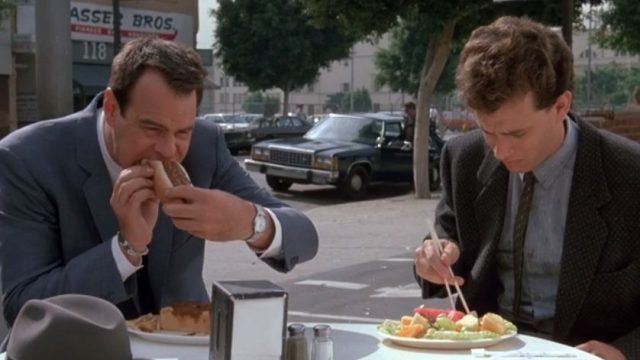There’s a scene of the 1987 movie Dragnet, starring Dan Aykroyd and Tom Hanks, set in downtown Los Angeles. Alas, a still of the exact moment seems to be beyond my searching capability at the moment. But Aykroyd and Hanks are in downtown Los Angeles, and they’re about to get into their car. Every time I watch the movie, I get distracted by looking behind them. The air quality, or lack thereof, is apparent in any number of scenes, but in that one—the Los Angeles of my own childhood—you can barely see more than a few blocks, because the air is an awful brown.
Moments like these often tell us more about the time the movie is set in than the plot does. Look at what’s considered normal. Period pieces will capture a lot of that. They’ll get the clothes, the cars, and the decorating, but there are always going to be little details that are impossible to recreate simply because there’s only so much they can do. You can’t get it all, because you won’t notice them all. Unless you happen to be looking.
Watch what people eat in restaurants in media. That’s a detail that doesn’t get pick up on as much. What people eat is what’s considered normal for a character in their time and place. I forget which Perry Mason novel it is that has an entire paragraph explaining the concept of tortilla chips, because they would be considered exotic for people outside the American Southwest. I have a cookbook that talks about canned tortillas, a concept that horrified me and brought about some interesting stories from some of my older Californian friends and family.
Landscaping is another weird quirk. Especially in the houses down the block from the one the characters are actually visiting. There’s fashion in these things—we here in Washington State curse whoever brought Scotch broom to our shores—and it’s one of those things that’s hard to capture for an entire block, and you certainly can’t capture it for everything your characters drive past. Sure, you can find period footage to rear project, but the film grain is going to give you away. That’s true of things like street signs, too.
Even before a single character shows up, you can often tell when something was shot. If you get a cityscape shot in Los Angeles, you can often peg the decade by the exact shade of grey-brown of the air. Obviously, cityscapes will also show you what buildings are there and which aren’t—New York skylines have an extremely simple way of dating something as being between 1973 and 2001, of course. But there are things you can tell even if you’re looking at a considerably smaller slice of the city.
My kids will notice pay phones in the things they watch from my childhood. I notice rotary dials. Everyone notices hair—the hairspray of the ’80s, the ubiquitous Rachel cuts of the ’90s—but it takes a subtler eye to pick up on fashion in earrings. Even something as specific as a billboard or the exact design of a bus or a gas station sign. All of these things contribute to the way a piece looks, and that gives as much to the mood as the particularly garish plaid on the blazer of a guy stalking Jim Rockford.
Help keep my family in something approaching recent styles by supporting my Patreon or Ko-fi!

